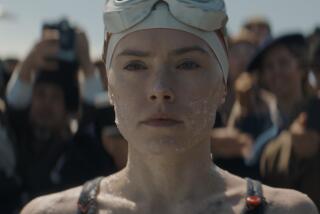A really fine kettle of fish
On the face of it, Wes Anderson’s new movie, “The Life Aquatic With Steve Zissou,” is an adventure tale about a Jacques Cousteau-on-the-skids-type who decides to pull an Ahab on the shark that ate his buddy. But mostly, like all Wes Anderson movies, it’s about being 11 1/2 -- it’s a recurring motif, anyway -- sometime around the late ‘70s, an age-era axis favored by Anderson and at least partly attributable to his current age of 35.
But Anderson doesn’t make nostalgic movies, exactly. He makes movies about the way nostalgia works on people -- which is different. All of his characters have longed for something weirdly ineffable, like the present, or the adult lives they imagined as kids. Oceanographer, documentarian and hubristic tragic hero Steve Zissou (Bill Murray) longs for all of the above -- plus a legacy; a son-figure; the reporter (Cate Blanchett) who has come to write a profile on him; a puff piece to get his career back on track; some money; a little consideration; a little understanding and revenge.
An exquisitely evocative movie that elevates rueful melancholia to a superpower, “The Life Aquatic,” co-written with Noah Baumbach, is not exactly a plot-lover’s pizza. Anderson is all about the resonant image, an anachronistic tic he cops to up front. Before the first character is introduced, the camera lingers in wide-angle on a large Renaissance tableau serving as a backdrop for a stage. It’s a familiar shorthand: Frame the vantage point, maybe hang drapes in the periphery, and wait for someone to meander into the frame. What we’re about to see is not reality but an artistic interpretation of it -- no more a “slice of life” than a slice of pie.
“The Life Aquatic” does that thing movies used to think they were supposed to do: paint with light, sculpt in time, drive you nuts with longing for something hard to pinpoint that you probably never had, deliver an emotional experience from which you won’t recover. In “The Life Aquatic,” this is achieved through an ineffable alchemy of red wool caps, pale blue Speedos, “Zissou” Adidas, acoustic David Bowie songs sung in Portuguese by a Brazilian crew member named Pele (namesake of the world’s greatest soccer player), the welling (twice) of Bill Murray’s tears and Tintin tableaux of the entire ragtag crew -- including a turban-wearing cameraman named Vikram -- crammed into a yellow deep-sea exploration vessel.
No doubt this endorsement isn’t inspiring fans of Spielberg to leap off the couch and get on the horn with MovieFone -- although Murray does single-handedly take on a band of Philippine pirates in a scene that’s a surreal version of somebody’s dream about “Apocalypse Now.” But this shark movie, which alludes to the other shark movie, which along with “Star Wars” is responsible for blockbustering into oblivion the best decade American movies ever saw, has something to say about that too. Not for nothing is the dead guy played by ‘70s icon Seymour Cassel, while Bud Cort of “Harold and Maude” fame is bound and gagged by pirates.
On the other hand, if you’ve already glued a statuette of Bill Murray, patron saint of inchoate yearning and exquisite disappointment, to your dashboard, nothing about “The Life Aquatic” will disappoint. Because talk about man against the universe.
We meet Steve Zissou at the premiere of his latest deep-sea documentary, barely enduring the Q & A. As much as it’s possible for an oceanographer’s life to do so, his has gone off the rails. His last five films have tanked. His marriage to Eleanor (Anjelica Huston), who is widely rumored to be “the real brains behind Team Zissou,” is on the rocks. His producer Drakoulias (Michael Gambon) is having trouble putting together financing for his next venture. His smarmy “nemesis,” Alistair Hennessey (Jeff Goldblum), erstwhile roommate and ex-husband of Eleanor, is hogging all the grant money. And, during the filming of “Secret of the Leopard Shark: Part I,” his best friend and partner, Esteban (Cassel), was eaten by the film’s elusive subject.
So for his next film, he tells the audience, he’d like to hunt down the shark and kill it.
“What would be the scientific purpose of killing it?” a woman asks.
“Revenge.”
But the leopard shark turns out to be a spotted McGuffin. The real story -- or as Steve sells it to Vikram, “the relationship subplot” -- begins when Steve is approached by young Ned Plimpton (Owen Wilson), a diffident pilot for Air Kentucky whom Steve quickly introduces as “probably my son.” Ned is the second reminder in about as many minutes of Steve’s many betrayals of Eleanor, but as far as Steve’s concerned, his timing couldn’t be better. As he tells Eleanor later, after his hubris and megalomania has caused the expedition to all but end in disaster, “I believe in the boy.”
“Why?”
“Because he looks up to me.”
“The world’s a ship on its passage out,” Melville wrote, and Zissou’s ship, the Belafonte (a sentimental nod to Cousteau’s Calypso) is truly a self-contained universe. “Let me show you my boat,” Steve says, and instantly the ship is bisected on screen like an organic specimen. There’s a spa, a kitchen, a library, a cutting room, a lab and an observation bubble (the idea for that came to Steve in a dream) in which one person can curl up and gaze out into the deep ocean.
Each is a separate space in which some aspect of human endeavor has been lovingly, painstakingly, classified -- a floating museum. Likewise, the Belafonte’s crew is Pequod-ishly international -- aside from Vikram, and Pele, there’s Bobby Ogata, Renzo Pietro and the sublime Klaus Daimler (Willem Dafoe, in his funniest role ever), Zissou’s petulant, shorts-wearing German engineer, whose worshipful love of Steve is matched only by his instant, perfervid resentment of Ned.
For newcomers Ned and Jane, the Belafonte is just the friendship station they’re looking for. Jane, who is pregnant, is writing a profile on her childhood hero. One suspects it has something to do with the fact that the baby’s father, her editor, is married to someone else and is rarely at his desk when she calls. But when Steve turns out to be not the man she imagined, she writes in her notebook, “The Zissou of my childhood represents all the dreams I’ve come to regret.”
She’s talking, I think, about the romantic, pre-adolescent view of adulthood in which all the things that seem most important (and all the things Anderson fetishizes) -- knowledge, science, great stories, adventure, the heroic mastery of a single pursuit, the awesome vastness and infinite variety of the world -- turn out to matter a lot less than previously imagined. It’s a totemic age and a high-water mark: the smartest, most curious, most imaginative a person can be before insecurity, toothpaste commercials, corporate training seminars and formulaic tent-pole movies -- in which heroes have no flaws and the antagonist always gets it in the end -- do their damage. One thing’s for sure, it’s been about 25 years since a lovable but deeply flawed and damaged guy could command a ramshackle vessel without first slapping on a helmet or sunscreen, fire up a smoke, say something insensitive, change his mind about the bad guy and still be called a hero.
*
‘The Life Aquatic With Steve Zissou’
MPAA rating: R for language, some drug use, violence and partial nudity
Times guidelines: Negligible nudity, some drug use, Speedos all over the place
Bill Murray...Steve Zissou
Owen Wilson...Ned Plimpton
Cate Blanchett...Jane Winslett-Richardson
Anjelica Huston...Eleanor Zissou
Willem Dafoe...Klaus Daimler
Jeff Goldblum...Alistair Hennessey
Michael Gambon...Oseary Drakoulias
Noah Taylor...Vladimir Wolodarsky
Bud Cort...Bill Ubell
Seymour Cassel...Esteban du Plantier
Touchstone Pictures Presents an American Empirical Picture. Produced by Wes Anderson, Barry Mendel, Scott Rudin. Executive Producer Rudd Simmons. Co-producer Enzo Sisti. Director of photography Robert Yeoman, ASC. Production designer Mark Friedberg. Edited by David Moritz. Costume designer Milena Canonero. Music by Mark Mothersbaugh. Music supervisor Randall Poster. Animation by Henry Selick. Casting by Douglas Aibel. Written by Wes Anderson and Noah Baumbach. Directed by Wes Anderson.
More to Read
Only good movies
Get the Indie Focus newsletter, Mark Olsen's weekly guide to the world of cinema.
You may occasionally receive promotional content from the Los Angeles Times.










